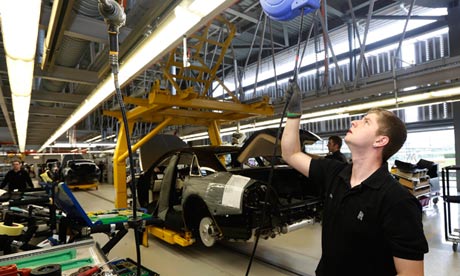
Britain's factories are boosting their output sharply amid signs that the pickup in the economy is spreading to the recession-battered manufacturing sector.
After falling in April and May, an across-the-board expansion led by the transport sector – including a buoyant automotive industry – saw production rise by 1.9% in June.
The increase was welcomed by employers' groups, who hope the Bank of England will help cement industry's fledgling recovery by committing on Wednesday to an extended period of low interest rates.
David Kern, chief economist at the British Chambers of Commerce (BCC), said: "After the disappointing figures we saw in May, this is positive news for the economy." He added:
"But we mustn't become complacent. The level of UK output is more than 3% below its pre-recession peak in 2008, and the manufacturing sector still faces major challenges over the months ahead. The government must do more to refocus its priorities towards policies that will enable businesses to drive the recovery."
Mark Carney, the new governor of the Bank of England, will on Wednesday outline Threadneedle Street's attitude to providing forward guidance to the financial markets about the future path of borrowing costs. The expectation in the City is that even after the upbeat figures of recent weeks, interest rates will not rise until 2015 at the earliest.
Tuesday's data from the Office for National Statistics showed that in the three months to June – a better guide to the underlying trend than the June figures alone – factory output was up by 0.7%. The month-on-month improvement for June was 1.9%.
Industrial production, which includes North Sea output and the domestic energy sector as well as manufacturing, grew by 0.6% in the second quarter of 2013 following a 1.1% jump in June.
The ONS figures prompted the National Institute for Economic and Social Research to raise its quarterly growth forecast for the UK economy from 0.6% in the three months to June to 0.7% in the quarter ending in July. The thinktank said the increase was helping to mop up some of the spare capacity in the economy generated by the deep recession of 2008-09, a downturn that was particularly severe on manufacturing.
Factory production dropped by 15% between the start of 2008 and the end of 2009 – double the rate of decline suffered by the economy overall – and after a slight recovery in 2010, manufacturing then entered a double-dip recession that has left output still more than 10% below its previous peak. Despite official GDP estimates of 0.6% growth in the second quarter, the level of GDP is 3.3% lower than it was in the first quarter of 2008.
NIESR said: "Consumer spending growth has underpinned the recent gains in economic momentum, in spite of the continued decline of real consumer wages. Our monthly GDP estimates are consistent with this pattern continuing in the three months ending in July 2013."
The ONS said manufacturing output was now at its highest level since 2012, and said transport equipment – where production grew by more than 5% – was the standout sector in June.
Lee Hopley, chief economist at EEF, the manufacturers' organisation, said: "Manufacturing output surged in June with the strongest pace of increase since the end of 2010. In contrast to the significant sector divergence we've seen in the data in recent years all parts of manufacturing posted gains with chemicals, electrical equipment and transport showing particular strength over the past three months. The production data gives further weight to the view that manufacturing activity will continue to gain pace, becoming a more important contributor to growth in the year ahead."
Nida Ali, economic adviser to the Ernst & Young ITEM Club, said car production was one of the highlights in a broad recovery for manufacturers. She said: "The preliminary GDP figures had suggested a solid increase in manufacturing output in June, but a monthly rise of 1.9% still came as a big upside surprise. The broad-based nature of the manufacturing pickup paints a positive picture, but there are some obvious sector hotspots. The healthy increase in car production supports the strong data on new car registrations, as well as suggesting evidence of export success.
"The manufacturing outlook has perked up considerably in recent months. On top of growth in the second quarter, survey data points to a further expansion in the third quarter and there are increasing signs that the recovery is broadening out from the consumer sector into exports and investment. Although this is encouraging, the manufacturing sector took a real battering during the crisis, so there is still a long way to go before pre-crisis levels will be restored."